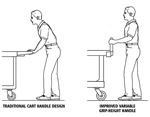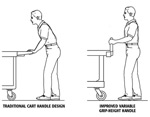
Move Big Loads Safely
Most material handling products last a long time. Older, non-functional products and heavier payloads mean end users face a number of frustrations.
- By Jenn Schneider
- Dec 01, 2009

Angled handle helps keeps the wrist and bones in forearm aligned for optimum leverage while turning.
You're in the market for a material handling product, something that can help your employees move those loads quickly and safely. You surf the Web and flip through catalogs, but how do you start to narrow your choices? The same way best-in-class manufacturers create innovative products: research, testing, and knowledge.
The R&D behind a material handling product starts in the field. It's how engineers "get smart" about the consumer and an industry need. "It's important, first and foremost, to research the end users and gain knowledge into the marketplace you're trying to penetrate. It's about listening to the needs of your customer," said Scott Singleton, Global Business team leader--Material Handling at Rubbermaid Commercial Products (RCP).
Senior Product Engineer Bob Tokash said interviews and research indicated the company's heavyduty material handling product line needed a handle that could significantly reduce the risk of fatigue and on-the-job injuries. Th at knowledge brought about an integrated variable grip-height handle designed to improve maneuverability and reduce muscle strain regardless of the user's height.
Diff erent handle aspects were combined to establish the final handle designs for trucks and carts based on a laundry list of testing that ranged from weight load thresholds to examining several sizes of power drills to establish a drill holder feature that would accommodate nearly all sizes.
Key Benefits
Most material handling products last a long time. They usually are not replaced until completely rendered useless. However, older, non-functional products and heavier payloads mean end users face a number of frustrations, including difficulty pushing and maneuvering, difficulty keeping small items (tools/parts) organized, trouble keeping contents inplace during transport and accommodating oversized items, and insufficient weight capacity.
Little to no innovation has been made in material handling, aside from the power assist category, in recent years, Singleton said. "In the industry today, the importance of ergonomics in manual equipment has largely gone ignored. Very few manufacturers address safety when they develop a product. They worry about weight load capacity and tout how much weight the piece of equipment can hold. I've heard reports of up to 4,000 pounds," he said. "The question is, can you safely use the product? It may hold the load, but you certainly can't move it or maneuver the load safely without the risk of causing injury."
Excellent material handling products offer five benefits to ensure safe transportation of heavy goods:
1. Ergonomics. Design features provide optimal hand placement to avoid slumping over as you transport your load, which can cause muscle fatigue.
2. Maneuverability. This coincides with ergonomics. Push height improvements offer better wrist and forearm alignment, giving end users greater leverage to maneuver heavy workloads while saving their backs.
3. Productivity. The easier it is to move that load, the less time you spend going back and forth and the more time you can spend on other tasks.
4. Durability. A durable/rugged platform deck ultimately means a lower overall cost-of-ownership over the service life of a product. Over time, wood and metal structures can splinter, warp, rot, and rust, which can create another set of safety issues.
5. Organization. Built-in features such as precut holes, storage compartments, and molded-in tie points for straps and bungees are great to keep items organized. They also help to secure loads in place.
When it comes to testing material handling products, it's all about being able to endure the harshest environments under heavy loads and providing a product that's rugged, durable, and tested tough, from static loads, fatigue, and impact/drop tests to cycling/ wear tests.
Some manufacturers have been known to use more than 300,000 pounds of weight to test a product line. For instance, "threshold" testing (a test designed to simulate going over a threshold as you would move materials around a facility) for one product can take up to 10,000 cycles, equivalent to 15 miles of actual distance on one unit.
Partnerships are everything. Know what you're buying and from whom. When looking to purchase material handling equipment, it's always smart to go with an industry leading manufacturer you can trust — one you can count on for breakthrough innovations that has a history of long-lasting products to meet your most demanding needs.
This article originally appeared in the December 2009 issue of Occupational Health & Safety.